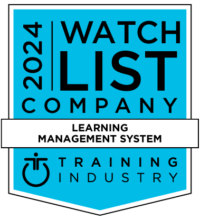Employees expect to be safe whether your workforce is on the road, working from home, in the office, or behind the counter. Safety matters—from sexual harassment prevention to unruly guests and workplace violence.
Keeping employees safe is a top priority for every organization, now more than ever. Between the lingering health risks of COVID-19, and various flu viruses, and a labor shortage that shows no sign of ending anytime soon, most employers are doing everything they can to protect employees, minimize lost time, and avoid the risk of lawsuits.
Unfortunately, the odds are not in their favor. Fatal jobsite injuries have reached their highest level in over a decade, and workplace injuries cost companies $171 billion a year according to the National Safety Council (NSC). Aside from physical risks, mental health complaints and workplace harassment are also up, and the pandemic has created a whole new set of challenges, as has the Great Resignation.
Adapting your safety training to keep pace with changing needs and requirements can be extremely challenging, but it’s also essential to protect employees and the organization. Here are six crucial safety topics that if not already in your training program, they should be.
Injury Prevention
It’s a no-brainer to say that ongoing training in safe equipment operation, trade-specific certifications, and staying up-to-date on the latest OSHA , EPA and transportation mandates are an absolute must. Don’t forget that in addition to federal mandates, many states also have specific OHSA (Cal/OSHA comes to mind) and state environmental requirements. Federal and state agencies are issuing more frequent updates as situations change, so make sure your company keeps on top of these moving targets and works with content providers who rapidly deploy updated courses that are compliant with the newest regulations.
Beyond the basics, you may want to add training on Repetitive Stress Injury (RSI) Prevention, a widespread problem that affects both office workers and manual labor positions. Understanding and controlling ergonomic risk factors can prevent musculoskeletal injuries and illnesses, and keep employees safe on the job for the long haul. It’s an investment in preventing lost time and long-term disability, as well as preserving skills and knowledge.
Remote work is also introducing workstation ergonomics and home office injury concerns. While OSHA may not hold employers liable for home office work, it does provide some guidance on what’s classified as “work-related” injuries sustained at home. Workers’ compensation laws compound the employer’s risk as these laws vary by state. This leads to a need to expand safety training in topics like Fall Prevention, Fire Extinguisher Basic Training, Electrical Safety and Proper Ventilation.
Inclusivity & Anti-Harassment
Federal EEOC laws protect employees and job applicants against discrimination when it involves unfair treatment because of race, color, religion, sex, origin, age, disability or genetic information. Additionally, seven states have recent or new mandates for sexual harassment prevention training, some of which include cultural diversity education. These regulations are specific to number of employees, staff roles, and often specify frequency of—and deadlines for—training.
During the pandemic, a large portion of employees say they have experienced more gender based, race/ethnicity-based and age-related harassment, hostility and abuse. Claims for unlawful retaliation in the workplace represented almost 56% of all EEOC charges filed in 2020. According to the EEOC annual report on workplace discrimination claims the number of retaliation claims were followed by discrimination based on disability (36%), race (33%), and sex (32%). And this was during the pandemic.
These issues are often exacerbated by employees working in more diverse, distributed teams and settings. Infractions are often times behind the security of a screen, where someone might say something online that they would never say in person. As with all digital communication, there’s a risk of losing context, body language and tone of voice. Given the stats, now is a good time to add modules to training programs and compliance technology to your systems to support a more inclusive culture where employees feel safe and your company doesn’t risk fines, litigation and brand reputation.
Emergency Protocols
You’ve covered all of the bases of safe working conditions, and let’s assume employees know what to do in the course of normal business. But what about when things are anything but normal? With polarization and tensions in society running high, we’re seeing an increase in unruly customers and incidents of workplace violence, not to mention fire and weather emergencies.
Do your employees know what to do if a disgruntled co-worker shows up with a gun? Or an estranged spouse begins harassing a staff member on the job? What if a tornado warning is issued?
Offering emergency training in subjects such as Active Shooter, Emergency Response Protocols, and First Aid/CPR training, even for employees who are not directly tasked with emergency response, can provide a safer work environment and help employees know what to do if things go wrong. In addition to safety training for fires and other emergencies, conduct regular drills so that people practice what to do—including securing any equipment to prevent further risk.
Substance Use
Most organizations already have strict policies against substance use in the workplace. Unfortunately, the pandemic has driven a surge in people drinking on the job, with 9 out of 10 drinking alcohol while working and an increase in substance use in general. The legality of recreational marijuana in at least 16 states complicates testing requirements, as well as creating a safety hazard.
Offering updated and ongoing training for Dealing with Drug and Alcohol Abuse is more essential than ever, especially with so many employees working offsite. Refresher training can clarify policy and overcome any questions or doubt from employees, as well as limit employer liability exposure in the event of accidents while under the influence or challenges to employee termination.
Proper PPE (Personal Protective Equipment)
While mask mandates currently dominate the PPE discussion, proper usage is still lacking. Employers may want to consider offering training in the correct fit and wearing of masks, as well as proper disposal.
With all of the talk about COVID protocols, it can be easy to neglect traditional PPE requirements and OSHA’s say on the matter. Employees become lax, forget or simply ignore recommendation for things like eye and ear protection, gloves/long sleeves, safety harnesses, etc., especially if they are uncomfortable or inconvenient. Offering frequent refresher trainings can keep PPE top of mind. And don’t forget weather-related safety topics too, such as Heat Stress and Cold Stress.
Stress Management
With widespread staff shortages, a lot of employees are feeling overworked and exhausted on top of dealing with COVID-related stress. While this might not seem like a safety concern at first blush, stress and anxiety can cause disengagement, inability to concentrate and lack of sleep, resulting in slow reaction times and loss of focus on the job. This can cause employees to make poor decisions, putting themselves and those around them at risk.
Mental health is just as important as physical health when it comes to a safe working environment. Offering Stress Management and Change Management training courses can help workers control behavior, stay alert, focused and safety minded. Learning better stress management can also help employees prevent long-term stress-related medical conditions like heart disease, gastrointestinal issues, obesity, and more.
Employees want to work for organizations that prioritize safety and well-being. They want to know that their workplace is safe, and that if violations or accidents occur, the organization will follow proper protocol. Being in compliance with federal, state, and trade-specific safety mandates is required for employers to successfully conduct business. Prioritizing safety as part of your workplace culture is just as important, impacting employee recruitment, engagement and retention strategies and outcome.






